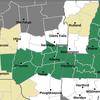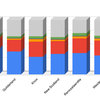‘Younger age groups’ dying of COVID-19
ALBANY COUNTY — The two latest county residents to die of COVID-19 were younger than those who typically succumb to the virus: a woman in her thirties and a man in his fifties.
They both had underlying health conditions, said Albany County Executive Daniel McCoy in making the announcement in a Sunday morning press release.
Starting on Sunday, New Yorkers with comorbidities are eligible to sign up for a vaccination. When Governor Andrew Cuomo first announced eligibility was being extended, he said that 94 percent of COVID-19 deaths were of patients with comorbidities.
To show they are eligible, New Yorkers can use a doctor's letter, medical information evidencing comorbidity, or signed certification.
“We’ve been seeing more deaths in younger age groups over the last few months. My condolences go out to their families,” said McCoy in a statement, announcing the latest deaths. “Starting today, those with comorbidities and underlying conditions can go to the state website to see if they are eligible to get the vaccine in this phase and register for a vaccine appointment.”
The county’s COVID-19 death toll now stands at 341.
New executive orders
Also on Sunday, Cuomo announced two new COVID-related executive orders.
Given the continued decline in hospitalization and infection rates throughout New York State, he signed an executive order extending closing times from 10 p.m. to 11 p.m. for bars, restaurants, gyms and fitness centers, casinos, and billiards halls, as well as other establishments licensed by the State Liquor Authority.
The new closing times began on Sunday.
Cuomo also signed an executive order extending the enrollment period for voters to make changes to their party enrollment until Tuesday, Feb. 16.
This change is necessary, a release from the governor’s office said, to ensure that boards of election have adequate time to process voter-requested changes considering many boards are short-staffed and operating with reduced density due to the COVID-19 public health emergency.
The change went into effect immediately.
In 2019, legislation was adopted to make it easier for voters to participate in primary elections. Previously, changes to party enrollment did not take effect until after the November general election, requiring voters to wait as long as a year for changes to take effect
The new law removed the Oct. 11 deadline and gave voters until Feb. 14 to make changes to party enrollment. Due to the public health emergency and the fact that this Feb. 14 is a Sunday followed by a holiday, this common-sense measure ensures the spirit of the law is complied with uniformly statewide, the release said.
Newest numbers
As of Sunday morning, Albany County has had 19,593 confirmed cases of COVID-19, including 101 new cases since Saturday.
Of the new cases, 62 did not have clear sources of infection identified, 31 had close contact with someone infected with the disease, and eight are health-care workers or residents of congregate settings.
At the University at Albany, COVID-19 testing on campus has turned up positive in 149 cases since Jan. 2, according to the SUNY COVID-19 Case Tracker. Broken into two-week periods, there were 35 cases from Jan. 2 to 15, then 18 cases from Jan. 16 to 29, and 96 cases from Jan. 30 to Feb. 12.
As of Sunday evening, there were 116 UAlbany students under mandatory quarantine and 38 in isolation — 30 of them on campus, and eight of them off campus.
The five-day average for new daily positives in Albany County has increased to 85.8 from 82.8. There are now 786 active cases in the county, down from 788 on Saturday.
The number of Albany County residents under mandatory quarantine decreased to 1,874 from 1,914. So far, 60,137 county residents have completed quarantine. Of those, 18,807 had tested positive and recovered. That is an increase of 92 recoveries since yesterday.
There were four new hospitalizations overnight, and there are now 74 county residents currently hospitalized from the virus. There are now 13 patients in intensive-care units, down from 14 on Saturday.
The Capital Region, according to a release from the governor’s office, saw a marked jump in its percentage of available hospital beds — to 29.06 percent. Even so, it still has the worst rate in the state.
In the midst of the post-holiday surge, St. Peter’s outfitted an unused portion of the county’s nursing home as a hospital in case the region reached capacity, a threat that appears to have subsided.
Currently, 264 Capital Region residents are hospitalized with COVID-19, which is 0.02 percent of the population, another drop for the former 0.03 percent, and the post-holiday surge rate of 0.04 percent.
Statewide, 0.03 percent of New Yorkers are hospitalized with the virus, which leaves 33.60 percent of the state’s hospital beds available.
Of the state’s 10 regions, the Capital Region continues to have the worst rate of ICU beds available, at 19 percent.
Currently 175 of the region’s 237 ICU beds are filled.
Statewide, 26 percent of ICU beds are available.
As of Saturday, the Capital Region’s infection rate, as a seven-day average, was 2.50 percent.
Statewide, the positivity rate is 3.83 percent.
The infection rate for Albany County, as of Saturday, as a seven-day rolling average, was 2.7 percent, according to the state’s dashboard.
The Capital Region, according to data released Sunday from the governor’s office, has administered 172,552 of the 214,270 vaccine doses it has been given this week, which is 81 percent.
Statewide, 83 percent of doses have been administered.
This is the ninth week that the state has received vaccine doses from the federal government, now totaling 3.4 million.


